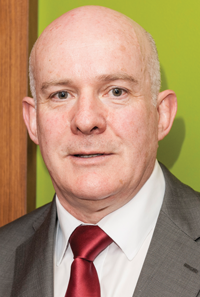Improving prison standards
 A capital reform programme is underway to update Ireland’s out-dated prison estate. Reducing re-offending through rehabilitation is key, Irish Prison Service Director General Michael Donellan tells Meadhbh Monahan.
A capital reform programme is underway to update Ireland’s out-dated prison estate. Reducing re-offending through rehabilitation is key, Irish Prison Service Director General Michael Donellan tells Meadhbh Monahan.
An efficient prison service is manifested in “outcomes, the humanity with which we treat those in our care and the respect we show for their fundamental rights,” according to Michael Donellan.
The poor state of some of Ireland’s prisons has been under scrutiny for many years. In 2009, the Inspector of Prisons Judge Michael Reilly published standards to be expected in Irish prisons. These included keeping all prisons clean, treating prisoners in a humane and ethical manner (e.g. by ending the practice of ‘slopping out’), having one person in a cell and allowing prisoners to practise their religion.
In response, the Irish Prison Service released its three-year plan which had the following six outcomes:
• implementing a 40-month capital plan (with an allocation of €34 million last year and €24 million this year) aimed at providing in-cell sanitation, beginning with the replacement of outdated accommodation and facilities in Cork prison, Limerick prison, Mountjoy prison and Portlaoise E Block;
• tackling overcrowding by implementing the Inspector of Prison’s recommendations, focusing in 2012 and 2013 on reducing chronic overcrowding in Mountjoy, Cork, Limerick and the Dóchas Centre (the female prison on the Mountjoy site);
• creating a prison system designed to “facilitate prisoner progression, training and rehabilitation” by carrying out a review of each prison’s function, internal prisoner progression programmes and committal status, and ending the detention of children in St Patrick’s Institution;
• improving prisoner outcomes by devising specific strategies for younger prisoners, women, older prisoners, sex offenders, violent offenders and those suffering from mental illness, and reducing the supply of drugs across the prison estate;
• introducing administrative grades such as prison administrative support officers and campus governors; and
• reviewing prison law to identify areas of law for repeal or reform.
The Irish Human Rights Commission and the UN Committee Against Torture have also been critical. When asked to respond to the criticisms, Donellan tells eolas: “They present challenges to me as Director General and I intend to meet them and bring urgency to the reform agenda that we’ve set out.” He adds: “[Central] to adherence to our human rights obligations is a prison system with accommodation and facilities that are fit for purpose in the 21st century. The Minister has provided significant capital resources which will provide in-cell sanitation for the first time in 100 years in Limerick, Cork and Mountjoy.”
Addressing an eolas justice seminar, Donellan explained: “Prisoners present to prison with a multitude of complex problems, the solution for which is not solely within the gift or remit of the criminal justice system.” Many come from chaotic backgrounds, have had poor experiences of the education system, have very basic literacy and numeracy skills or have an addiction. “All prisoners share one thing in common,” Donellan stated. “They have been sent to prison as punishment, not for punishment.”
Rehabilition
“There’s no doubt that prison life is more complex over the past 10 years because of the amount of rival gangs within prison, usually over drugs and illegal activities,” Donellan comments.
He is wary of prisoners falling back into their old ways after making progress during prison rehabilitation programmes. “The progress prisoners make in prison can all be lost following their release without the necessary supports including accommodation, housing and addiction needs,” he emphasised.
Data on the rate of re-offending does not exist and Donellan points to the much cited 2006 study undertaken by the UCD Institute of Criminology (and facilitated by the Prison Service), which found that the recidivism rate, after four years, was 49.2 per cent. The Justice Minister has stated that the Probation Service is in the process of conducting research into recidivism and collating the relevant data.
To prevent re-offending, the Prison Service intends to ensure that sentence management (pre-and-post imprisonment) includes enhancing sentence planning and prison rehabilitation programmes such as education, work placement and resettlement. Over the next three years it will introduce plans for “tangible incentives for prisoners to participate in structured activities.”
Donellan states: “Rehabilitation is not achieved overnight and the Prison Service possesses no magic wand which allows it single handily to address the complex range of problems that many prisoners have.”
Innovation
Donellan cites the community return project as an example of innovation that is reducing the numbers in prison and those on temporary release. Temporary releases have risen from 153 (5 per cent of committals) in 2010 to 732 (17 per cent) in 2010. “It is swapping prison time for community service,” he explains. Almost 200 prisoners have been released through the scheme in the past six months, Donellan reports. “Prisoners can be considered for community return at 50 per cent of their sentence being served for particular categories of crime; they are supervised in the community by the Probation Service and are returned to prison if they don’t comply.”
A pilot social investment bond is set to focus on working with short term prisoners “in a meaningful way, helping them with housing and medical care,” he adds. “We are hoping to raise money, where we can focus on people who serve sentences of 12 months or less in supporting them not to come back to prison.”
Eight existing prisons will be clustered in three new prison campuses: four on the Mountjoy campus (Mountjoy Prison, Dóchas Centre, the Training Unit and St Patrick’s Institution), two in west Dublin (Cloverhill and Wheatfield) and two in the Midlands (Portlaoise and Midlands). These will be run by campus governors.
The Prison Service is also reviewing how it uses video conferencing and Skype as a substitute to staff escorting of prisoners to venues all over the country. “It’s about developing that technology to its maximum,” Donellan says.
Overall, Donellan believes that meaningful change will be manifested in “the successful reintegration of prisoners into the community, the ending of slopping out within the 40 months and stopping re-offending.”





